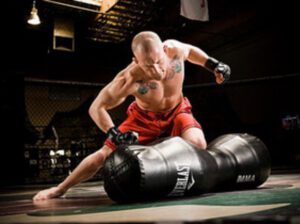After close to 2 decades of working with more than a thousand young athletes, I’ve come to some very sound and field-tested conclusions. But this report isn’t about the fact that I know everything – it’s a reflection of the mistakes I’ve made as a Coach and how finding the correct solutions proved to be incredibly helpful in terms of making my young athletes the very best they could be. I’ve been honored and blessed to have worked with National Team Competitors, Professional Athletes, High School and College Standouts as well as youth sports superstars. I’ve made every mistake in the book and learned from them all. I can tell you with 100% certainty that these “7-Mistakes”, if you’re making them, are the #1 reason your young athletes will never become the very best they can be.
The 7-Mistakes you’re likely making are:
1. Linear Speed vs. Multi-Directional Speed
2. Short-Term Gain vs. Long-Term Development
3. Heavy Load Before Technique
4. Coaches & Facilities Not Educated in Youth Sport Training
5. Over-Specialization in Training
6. Over-Specialization in Sport
7. Heavy Focus on the ‘Big 3’
Mistake #1 – Linear Speed vs Multi-Directional Speed
It is customary to see young athletes being taught and drilled on how to run as fast as possible in a straight line. Coaches spend hours teaching the mechanics of ‘linear speed’. Arm drive, hip drive, ankle push, forward lean – all the usual suspects. Whether on a high speed treadmill, gymnasium floor or football field, anywhere you go, you’ll likely see coaches teaching the techniques of running fast in a straight line moving forward. Now, I don’t really have any fundamental issue with respect to this style of training. I could (and will) argue that virtually every sport is played in a non-linear format and so spending time on the mechanics of an exercise that a young athlete won’t typically ever need in a sporting situation is paramount to a large waste of time. But young athletes (as you will read later) need to be exposed to as much training stimulus as possible – in all formats. In that, no training style should ever be considered ‘not worth the time’ when we’re talking about pre-adolescent or high school aged athletes. But the fact that linear speed training is both taught and drilled INSTEAD of more functional and useable styles of speed and agility work is where I draw the concern. Football, baseball, soccer, basketball, volleyball – you name the sport. Very seldom does a young athlete need to sprint forward with proper form; and they almost never hit ‘top-end-speed’ for any length of time. If you look at any of the sports from a positional standpoint, that reality is even less likely. Sports are multi-directional and vary in speed. Young athletes must be taught how to move efficiently and quickly at angles (not just forward) and be ingrained with the knowledge and ability of how to decelerate (stop) and shift (change directions) as fast as possible. Sport speed isn’t about straight lines. It’s about angular quickness and the ability to re-accelerate.
Mistake #2 – Short-Term Gain versus Long-Term Development
It is very standard for coaches and training facilities to both “sell” parents on the fact that the young athletes in their care will become decidedly better in only 6 or 8 weeks worth of training. And in fact, they’re correct in saying so. But not because their training system is somehow superior or because they possess unique talents as a coach. Quite simply, it’s because human beings are adaptive machines that alter (become better) under the strain of applied demand (training). This is especially true for young people in the age bracket of 6-18. This time of life represents a literal coming of age with respect to maturation and athletic ability. The Central Nervous System is learning to master the art of movement, bones are growing more dense and muscles are becoming naturally longer and more powerful. You could, quite literally, ask a 15 year-old soccer player to run stairs 3 times per week for 6 weeks and show improvements to both their speed and power output capacity. That doesn’t mean running stairs is an efficient training style, it just means that the human body is designed to accommodate the stress it is placed under by getting faster and stronger. In short – with young athletes, EVERYTHING works… But what works best? In response to the point raised in the ‘Mistake #2’ title, we need to look beyond trying to get young athletes better right now. They will get better as a natural result of training – that’s the point I made above. What focus must be on is the long-term gains that will make them better (optimally better) over time. Look at it from this angle: Could your child pass Grade 2 in 6 weeks? Could they obtain a Masters Degree before they graduated from High School? In academics, there is a need to progress through a systemic process of knowledge acquisition. When done well and in proper sequence, optimal intelligence is gained and your child has the ability (although perhaps not desire!) to become a world-class rocket scientist. Without the process or long-term sequence, their ability to excel in anything would be greatly diminished.
Mistake #3 – Heavy Load before Technique
Coaches (and some parents) love to watch their ‘prized-bulls’ squatting or bench pressing hundreds of pounds of iron. Make no mistake; the young athletes love it as well.
But far too often, this desire to be as strong as possible as quickly as possible can lead to some serious dangers that could cause irreparable injury. Optimal strength in sport is a necessity. Strong athletes are fast and agile. Strong athletes are injury-resistant. Strong athletes are durable and tough. But gaining strength cannot come from throwing barbells around in the weight room – not without solid technique as the cornerstone of the discussion. Teaching how to produce force (squat, bench press or jump) properly needs to be job #1 of any coach or trainer working with youngsters. And contrary to popular opinion, using ‘strength training machines’ as a supplement or surrogate to minimize the risk of injury is 100% the wrong choice. Functional strength is critical. Squatting and other strength-type exercises like it are necessary for sporting success (and injury prevention). The use of any static sort of machine that mimics but cannot duplicate free motion strength training will only add to the injury potential issue. Strength training is important – but any coach worth his or her salt knows how to teach it well before they add external weight.
Mistake #4 – Coaches and Facilities Not Educated in Youth Sports Training
I started this post by telling you that I have worked with Division-1, National Team Competitors and Professionals Athletes. But I’m also happy to tell you that none of those experiences make me qualified to train your child. Neither would I be qualified if I had an Olympic Medal around my neck or a Super Bowl ring on my index finger. We constantly mistake ‘big names’ or ‘big credentials’ as qualified. Let me put it this way. The most impressive and decorated mathematician at NASA is a literal genius with the topic of math, but would you really think them qualified and ideal to teach your 7 year-old son how to multiply? Success in sport or at the highest level of coaching doesn’t mean that one is suited to understand and be fluent in the unique sciences of youth sports training. Seek experience and education pertaining to the specialty at hand – not glitz and glamour.
Mistake #5 – Over-Specialization in Training
You’ve heard the term ‘Sport-Specific-Training’ before, correct? Well, let me give you the cold hard facts. It doesn’t exist. Especially not with young athletes. When working with pre-adolescent and high school athletes, the undeniable reality is that we are trending to an organism that is in the process of growth. And that fact is something that we cannot do anything about, nor cause disruption to the process of. What a growing and maturing body needs in order to remain injury-free and develop optimal athletic skill is variety. With respect to training, this amounts to NOT having a hyper-focus on making a young athlete a better football player by only doing exercises in the gym that the NFL players would do. The strongest and fastest athletes in any sport are the ones’ who had the greatest diversity of training while they were young. And believe it or not, this means that the training program for a female soccer player shouldn’t deviate that much from a male baseball player. In time, more specific training programs will be necessary to maintain or improve upon the strength and power needs for a specific sport or position. As a general rule, throughout high school, roughly 70% of a young athletes training program should be based on general fitness and athletic ability.
Mistake #6 – Over-Specialization in Sport
If I told you that because your daughter liked math and was good at it, you should remove every other academic topic from her daily, monthly, and annual calendar and only allow her to learn math, would you believe that this was a good idea? Would you argue that the only way to eventually become an authority in a given area of study was to have a well-rounded brain, rich in exposure to other subjects like English, Art and History? Well…. You’d be right! Now, all you need to do is apply that same logic to sports. To become the best baseball player possible, you must first become the best athlete you can be. Early immersion in any specific sport is the single greatest cause I have ever seen to young athletes not living up to their potential. The basis for this reasoning is due to the plastic nature of the nervous system that exists while we are young. To be plastic means to be adaptable – kids are inherently more adaptable than adults, and the reason they are better suited to learn new languages or athletic skills. The more exposure a young person has to a diverse array of sporting opportunities, the more they will be able to learn, master, and perfect the advanced skills involved in any sport you can name. The very best sport specialists in the world are also the very best athletes. It’s just that simple.
Mistake #7 – Heavy Focus on the ‘Big 3’
The ‘Big 3’ are Strength, Flexibility and Cardiovascular. Those are the things most adults train when they walk into a gym. But they are NOT what young athletes need to be spending their time on – at least not exclusively. A mammoth concern I have is when I watch coaches who train young athletes working on these three items of the physical ability spectrum only. Training young athletes is about more, SO much more. Coordination has more than 10 separate components including: balance, kinesthetic differentiation, spatial awareness, movement adequacy, and rhythm. Flexibility is about the length of tissue surrounding a joint, but mobility is necessary for ensuring that a joint moves through proper ranges (thereby reducing injury risk and increasing strength, speed, and power). Children are not little adults and shouldn’t be trained as such.
Refer back to “Mistake #4” and find a qualified professional in your area. Kids are our most precious resource. It’s about time we started treating them that way.
Best Regards,
Coach David G.
How useful was this post?
Click on a star to rate it!
Average rating 0 / 5. Vote count: 0
No votes so far! Be the first to rate this post.

